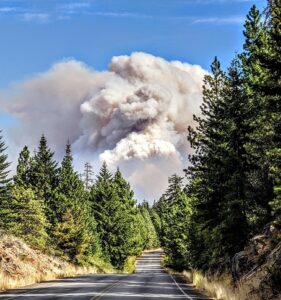
The Mt. Hood National Forest provides clean water, recreation, forest products, and wildlife to the region. But these values are at risk from large and severe fires.
Nearly 200,000 acres of the Mt. Hood National Forest have burned since last year- threatening communities, water supplies and public health.
We are also losing access. The US Forest Service has also closed over 250 miles of forest roads due to hazards posed by dead and dying trees from the fires.
The Mt. Hood National Forest needs active, multiple-use management to reduce wildfire risks, increase public access, provide recreation, and support family-wage jobs in the region.
U.S. Rep. Earl Blumenauer (D-Portland) is developing legislation for the Mt. Hood National Forest to: 1) establish a 337,875-acre Recreation Area; 2) designate an additional 29,030 acres of Wilderness; and 3) designate an additional 106 miles of Wild and Scenic Rivers, impacting 60,200 acres of federal lands. About 1/3 of the National Forest is already designated as Wilderness, so these land designations could make reducing wildfire risks and maintaining public access even more difficult.
Rep. Blumenauer’s office is accepting public comments on his proposals through Friday, January 7, 2022. Comments can be submitted directly to Congressman Blumenauer’s form at this link.
You can support forest management on the Mt. Hood National Forest by sharing these key messages:
- Protecting Mt. Hood and its natural features requires proactive, science-based active forest management, including thinning fire-prone forests and improving forest resilience to wildfire.
- Protecting communities at risk of wildfire requires giving public land managers the ability to use all available forest management tools to plan and implement effective forest treatments to mitigate wildfire risk and protect public health and safety from fire and smoke.
- The Portland Metro Area depends on watersheds on Mt. Hood for much of its water supplies. Considering recent wildfires on the Mt. Hood National Forest, legislation should not preclude the ability of public land managers to implement treatments on the National Forest in a timely manner.
- Land designations such as Wilderness, Wild & Scenic River, and Recreation Areas preclude or dissuade active forest management. Arbitrary land designations will do nothing to enable the U.S. Forest Service to improve effective land management; they will, instead, make such management more difficult.
- Sustainable and equitable outdoor recreation requires a robust, reliable and well-maintained network of forest roads for motorized and non-motorized recreation.
- Considering the Mt Hood National Forest has 257 miles of roads closed due to hazard trees related to the Riverside, Lionshead and White River Fires, public land managers should have the ability to remove dead and dying trees to maintain safe public access.
Please get involved and make your voice heard. Submit your public comment before Friday, January 7, 2022 by clicking here.



